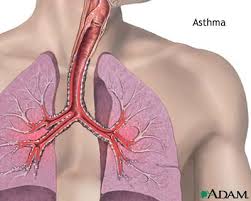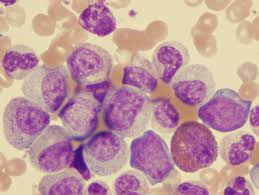Many patients with eye melanoma don't have symptoms unless the cancer grows in certain parts of the eye or becomes more advanced. Signs and symptoms of eye melanomas can include:
- decreased ability to see
- floaters (spots or squiggles drifting in the field of vision) or flashes of light
- visual field loss (losing part of your field of sight)
- a growing dark spot on the iris
- a change in position of the eyeball within its socket
- bulging of the eye
- a change in the way the eye moves within the socket
Pain is quite rare except in cases of massive spread outside the eye. In such a case, bulging or a change in the position of the eye may also be noted. Other, less serious conditions can cause some of these symptoms. For example, floaters may occur as a normal part of the aging process. Still, if you have any of these symptoms, it's important to see a doctor right away so the cause can be found and treated, if needed.
Eye ExamExamination of the eye by an ophthalmologist (a medical doctor specializing in diseases of the eye) is often the most important step in diagnosing melanoma of the eye. The doctor will look for enlarged blood vessels on the outside of the eye, which can be a sign of a tumor inside the eye. The ophthalmologist may also use special instruments to get a good look inside the eye for a tumor or other abnormality.
- An ophthalmoscope (also known as a direct ophthalmoscope) is a hand-held instrument consisting of a light and a small magnifying lens.
- An indirect ophthalmoscope and a slit lamp is more like a large microscope, often providing a more detailed view of the inside of the eye than the direct phthalmoscope.
Most of the time, an eye exam alone can make the diagnosis. In some cases, imaging tests such as ultrasound may be required to confirm the diagnosis. Very rarely will a biopsy also be needed. Many people have a benign tumor in the eye called a choroidal nevus, which can sometimes be mistaken for an eye melanoma. A small number of these will eventually turn into melanomas. If your ophthalmologist spots one of these, he or she will likely advise regular eye exams to see if it grows.Even if you have recently had your eyes examined by an ophthalmologist or optometrist, if you start to have any of the symptoms listed above, get another exam. Sometimes these tumors are missed or grow so fast that they weren't there when you were last examined.If symptoms and/or the results of the eye exam suggest cancer might be present, more involved tests will likely be done. These might include imaging tests or other procedures.
Imaging TestsImaging tests use sound waves, x-rays, or magnetic fields to create pictures of the inside of your body. Imaging tests may be done for a number of reasons, including to help find a suspicious area that might be cancerous, to learn how far cancer may have spread, and to help determine if treatment has been effective.
Ultrasound: This is an important test for helping to diagnose eye melanomas. Ultrasound is a very common test that is often used in pregnant women to look at the fetus. But it can be applied anywhere in the body. For this test, a small instrument is placed up against the eyeball and high frequency sound waves are sent through the eye. The instrument picks up the pattern of echoes that comes back, which is converted into an image on a computer screen. This test is especially useful for diagnosing eye melanomas because they have a specific appearance on ultrasound. Using this test, doctors can confirm a diagnosis of melanoma of the eye in most cases.If you have already been diagnosed with eye melanoma, ultrasound may also be used to look for tumors in the liver, which is a common site of spread of this cancer.
Angiography: This is another technique used by ophthalmologists to help diagnose melanoma of the eye. A fluorescent dye is injected into the bloodstream through a vein in the arm. Pictures of the back of the eye are then taken with light that causes the dye to fluoresce (glow). Although melanomas do not have a special appearance with this test, some other eye problems do. Doctors can use this method to tell if something is not a melanoma.
Chest x-ray: If you have been diagnosed with eye melanoma, a plain x-ray of your chest may be done to see if the cancer has spread to your lungs. This is very unlikely unless your cancer is far advanced. This x-ray can be done in any outpatient setting. If the results are normal, you probably don't have cancer in your lungs.
Computed tomography (CT or CAT) scan: The CT scan is an x-ray procedure that produces detailed cross-sectional images of your body. Instead of taking one picture, like a conventional x-ray, a CT scanner takes many pictures as it rotates around you. A computer then combines these pictures into images of the part of your body being studied. CT scans are sometimes used to see if a melanoma has spread outside of the eye into nearby structures. It may also be used to look for spread of the cancer to distant organs such as the liver. Prior to the scan, you may be asked to drink a contrast solution and/or get an intravenous (IV) injection of a contrast dye that helps better outline abnormal areas in the body. You may need an IV line through which the contrast dye is injected. The injection can cause some flushing (redness and warm feeling). Some people are allergic and get hives or, rarely, more serious reactions like trouble breathing and low blood pressure. Be sure to tell the doctor if you have ever had a reaction to any contrast material used for x-rays. You need to lie still on a table while the scan is being done. During the test, the table moves in and out of the scanner, a ring-shaped machine that completely surrounds the table. You might feel a bit confined by the ring you have to lie in while the pictures are being taken. In recent years, spiral CT (also known as helical CT) has become available in many medical centers. This type of CT scan uses a faster machine. The scanner part of the machine rotates around the body continuously, allowing doctors to collect the images much more quickly than standard CT. As a result, you do not have to hold your breath for as long while the image is taken. This lowers the chance of blurred images occurring as a result of breathing motion. It also lowers the dose of radiation received during the test. The slices it images are thinner, which yields more detailed pictures.
Magnetic resonance imaging (MRI) scan: Like CT scans, MRI scans provide detailed images of soft tissues in the body. But MRI scans use radio waves and strong magnets instead of x-rays. The energy from the radio waves is absorbed and then released in a pattern formed by the type of body tissue and by certain diseases. A computer translates the pattern into very detailed images of parts of the body. A contrast material called gadolinium is often injected into a vein before the scan to better see details. MRI scans may be a little more uncomfortable than CT scans. They take longer -- often up to an hour. You may be placed inside a large cylindrical tube, which is confining and can upset people with a fear of enclosed spaces. Newer, "open" MRI machines can help with this if needed. The MRI machine makes buzzing and clicking noises that you may find disturbing. Some places will provide earplugs to help block this out. MRI images are often used to determine the extent of a tumor's growth and spread. They are particularly useful in examining eye tumors. They are also helpful in detecting cancer that has spread to the brain or spinal cord, as well as any spread of the melanoma outside the eye orbit.
BiopsyIn this procedure, a small, hollow needle is passed into the eye, and cells from the tumor are sucked up into a small syringe. The sample is sent to a lab, where a doctor called a pathologist looks at the cells under a microscope. A biopsy is needed to confirm the diagnosis of most cancers, but it is usually not used for eye melanomas because it is hard to do and risks damaging the eye and possibly spreading the tumor outside the eye. Because of this, and because almost all cases can be accurately diagnosed by the eye exam and imaging tests, most people with melanoma of the eye are treated without having a biopsy. This may change in the future. New technology may make biopsy safer in situations where the diagnosis is uncertain.
Blood testsLiver function tests: If you have been diagnosed with eye melanoma, your doctor may order blood tests to see how well your liver is functioning. Abnormal test results can sometimes be a sign that the cancer has spread to the liver.
Diagnosing intraocular lymphoma
Signs and symptoms of intraocular lymphomaThe possible signs and symptoms of eye lymphomas include:
- blurred vision or loss of vision
- seeing floaters (spots or squiggles drifting in the field of vision)
- redness or swelling in the eye
- sensitivity to light
- eye pain (uncommon)
- Intraocular lymphoma most often affects both eyes. Other, less serious conditions can cause some of these symptoms.
For example, floaters may occur as a normal part of the aging process. Still, if you have any of these symptoms, it's important to see a doctor right away so the cause can be found and treated, if needed.
Eye ExamDuring an eye exam, the doctor will use an ophthalmoscope (an instrument with a light and a small magnifying lens) to get a good look inside the eye. If lymphoma is present, the doctor may see that the vitreous (the jelly-like substance that fills most of the inside of the eye) is cloudy.
Imaging TestsMost of these tests are described in more detail in the section on diagnosing melanomas.
UltrasoundUltrasound is usually done to assess the nature of the mass (tumor), especially if there is no direct view of the back of the eye.
MRI scanMRI is often done not only to see the eye better, but also to look for lymphoma in the brain or meninges (the thin layers of tissue that surround the brain and spinal cord), which are common sites of spread of this cancer.
CT scanCT scans are used less often than MRI scans for eye lymphoma because they do not provide as much detail.
Positron emission tomography (PET) scanFor a PET scan, you receive an injection of glucose (a form of sugar) that contains a radioactive atom. The amount of radioactivity used is very low. Because cancer cells in the body are growing quickly, they absorb large amounts of the radioactive sugar. A special camera can then be used to create a picture of areas of radioactivity in the body. The picture is not finely detailed like a CT or MRI scan, but it can provide helpful information about your whole body. A PET scan can help give the doctor a better idea of whether the cancer has spread to lymph nodes or other parts of the body. A PET scan can also be useful if your doctor thinks the cancer may have spread but doesn't know where. Some newer machines are able to perform both a PET and CT scan at the same time (PET/CT scan). This allows the doctor to compare areas of higher radioactivity on the PET scan with the more detailed appearance of that area on the CT.
BiopsySymptoms and the results of exams and tests may suggest that intraocular lymphoma is present, but a biopsy is usually needed to confirm the diagnosis. To biopsy the eye, an ophthalmologist does a procedure called a vitrectomy, in which he or she takes a sample of the vitreous gel from inside the eye. The doctor inserts very small instruments into the eye, cuts the vitreous, and then sucks some of it out. The cells in the biopsy sample are then sent to a lab to be looked at under a microscope and tested by other special techniques. For more information on the lab tests done on suspected lymphoma specimens, see our document, Non-Hodgkin Lymphoma.
Lumbar puncture (spinal tap)This procedure is used to look for lymphoma cells in the cerebrospinal fluid (CSF), which is the liquid that surrounds the brain and spinal cord. It is done in cases of known or suspected eye lymphomas because these cancers may spread to the brain. For this test, you lay on your side on a bed or exam table with your knees up near your chest. The doctor first numbs an area in the lower part of the back near the spine. A small, hollow needle is then placed between the bones of the spine to withdraw some of the fluid. The fluid is then examined under a microscope to look for lymphoma cells. Other tests may be done on the fluid as well

 4:06 AM
4:06 AM
 Ronald Setiawan
Ronald Setiawan

 Posted in:
Posted in: 





















